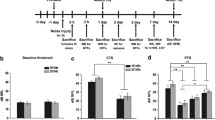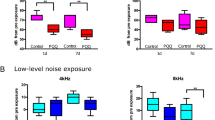Abstract
Sensorineural hearing loss is an intractable disease. Acoustic overstimulation creates hearing loss; many patients exhibit social and emotional dysfunctions. In a model of noise-induced hearing loss (NIHL), low-level laser photobiomodulation (PBM) at a near-infrared wavelength significantly improved auditory brainstem response (ABR) thresholds. In addition, both N-acetyl-L-cysteine (NAC) and acetyl-L-carnitine (ALCAR) attenuated NIHL, reducing the effects of noise trauma in the cochlea and the central auditory system. Here, we combined PBM with antioxidants to explore hearing threshold recovery and morphological hair cell changes after rats were exposed to noise. The average auditory brainstem response thresholds after PBM/NAC combination treatment were reduced from the apex to the basal turn at all of 8, 16, and 32 kHz compared to the noise-only group. The PBM/NAC combination treated group exhibited intact outer hair cells in all turns, and significantly greater hair cell numbers in the middle and basal cochlear turns, than did controls. Thus, PBM/NAC treatment may prevent hearing dysfunction caused by NIHL.




Similar content being viewed by others
References
Vaisbuch Y, Santa Maria PL (2018) Age-related hearing loss: innovations in hearing augmentation. Otolaryngol Clin N Am 51(4):705–723. https://doi.org/10.1016/j.otc.2018.03.002
Wong AC, Ryan AF (2015) Mechanisms of sensorineural cell damage, death and survival in the cochlea. Front Aging Neurosci 7:58. https://doi.org/10.3389/fnagi.2015.00058
Campo P, Morata TC, Hong O (2013) Chemical exposure and hearing loss. Dis Mon 59(4):119–138. https://doi.org/10.1016/j.disamonth.2013.01.003
Ghent RM Jr (2016) Can industrial chemical exposure cause hearing loss? Occup Health Saf 85(6):1618–1620
Wu SS, Yu JN, He CH, Mu HX, Wang C, Zhang Y, Zhang CY, Yu SF, Li XL (2016) Current status of hearing loss and related influencing factors in workers with noise exposure in refining and chemical industry. Zhonghua Lao Dong Wei Sheng Zhi Ye Bing Za Zhi 34(12):917–919. https://doi.org/10.3760/cma.j.issn.1001-9391.2016.12.008
Metidieri MM, Rodrigues HF, Filho FJ, Ferraz DP, Neto AF, Torres S (2013) Noise-induced hearing loss (NIHL): literature review with a focus on occupational medicine. Int Arch Otorhinolaryngol 17(2):208–212. https://doi.org/10.7162/S1809-97772013000200015
Le TN, Straatman LV, Lea J, Westerberg B (2017) Current insights in noise-induced hearing loss: a literature review of the underlying mechanism, pathophysiology, asymmetry, and management options. J Otolaryngol Head Neck Surg 46(1):41. https://doi.org/10.1186/s40463-017-0219-x
Ryan AF, Kujawa SG, Hammill T, Le Prell C, Kil J (2016) Temporary and permanent noise-induced threshold shifts: a review of basic and clinical observations. Otol Neurotol 37(8):e271–e275. https://doi.org/10.1097/MAO.0000000000001071
Rhee CK, Bahk CW, Kim SH, Ahn JC, Jung JY, Chung PS, Suh MW (2012) Effect of low-level laser treatment on cochlea hair-cell recovery after acute acoustic trauma. J Biomed Opt 17(6):068002. https://doi.org/10.1117/1.JBO.17.6.068002
Lee JH, Lee MY, Chung PS, Jung JY (2019) Photobiomodulation using low-level 808 nm diode laser rescues cochlear synaptopathy after acoustic overexposure in rat. J Biophotonics 12(11):e201900145. https://doi.org/10.1002/jbio.201900145
Hahad O, Prochaska JH, Daiber A, Muenzel T (2019) Environmental noise-induced effects on stress hormones, oxidative stress, and vascular dysfunction: key factors in the relationship between cerebrocardiovascular and psychological disorders. Oxidative Med Cell Longev 2019:4623109. https://doi.org/10.1155/2019/4623109
Wu F, Xiong H, Sha S (2020) Noise-induced loss of sensory hair cells is mediated by ROS/AMPKalpha pathway. Redox Biol 29:101406. https://doi.org/10.1016/j.redox.2019.101406
Fetoni AR, Paciello F, Rolesi R, Paludetti G, Troiani D (2019) Targeting dysregulation of redox homeostasis in noise-induced hearing loss: oxidative stress and ROS signaling. Free Radic Biol Med 135:46–59. https://doi.org/10.1016/j.freeradbiomed.2019.02.022
Chen GD, Daszynski DM, Ding D, Jiang H, Woolman T, Blessing K, Kador PF, Salvi R (2020) Novel oral multifunctional antioxidant prevents noise-induced hearing loss and hair cell loss. Hear Res 388:107880. https://doi.org/10.1016/j.heares.2019.107880
Lee SY, Han JJ, Jung G, Min HJ, Song JJ, Koo JW (2020) Outcomes of peptide vaccine GV1001 treatment in a murine model of acute noise-induced hearing loss. Antioxid (Basel) 9(2). https://doi.org/10.3390/antiox9020112
Choi SH, Choi CH (2015) Noise-induced neural degeneration and therapeutic effect of antioxidant drugs. J Audiol Otol 19(3):111–119. https://doi.org/10.7874/jao.2015.19.3.111
Kopke R, Slade MD, Jackson R, Hammill T, Fausti S, Lonsbury-Martin B, Sanderson A, Dreisbach L, Rabinowitz P, Torre P 3rd, Balough B (2015) Efficacy and safety of N-acetylcysteine in prevention of noise induced hearing loss: a randomized clinical trial. Hear Res 323:40–50. https://doi.org/10.1016/j.heares.2015.01.002
Ada S, Hanci D, Ulusoy S, Vejselova D, Burukoglu D, Muluk NB, Cingi C (2017) Potential protective effect of N-acetyl cysteine in acoustic trauma: an experimental study using scanning electron microscopy. Adv Clin Exp Med 26(6):893–897. https://doi.org/10.17219/acem/64332
Kopke R, Bielefeld E, Liu J, Zheng J, Jackson R, Henderson D, Coleman JK (2005) Prevention of impulse noise-induced hearing loss with antioxidants. Acta Otolaryngol 125(3):235–243. https://doi.org/10.1080/00016480410023038
Sansone RA, Sansone LA (2011) Getting a Knack for NAC: N-Acetyl-Cysteine. Innov Clin Neurosci 8(1):10–14
Moon TH, Lee MY, Jung JY, Ahn JC, Chang SY, Chung PS, Rhee CK, Kim YH, Suh MW (2016) Safety assessment of trans-tympanic photobiomodulation. Lasers Med Sci 31(2):323–333. https://doi.org/10.1007/s10103-015-1851-1
Palmer LA, Doctor A, Chhabra P, Sheram ML, Laubach VE, Karlinsey MZ, Forbes MS, Macdonald T, Gaston B (2007) S-nitrosothiols signal hypoxia-mimetic vascular pathology. J Clin Investig 117(9):2592–2601. https://doi.org/10.1172/JCI29444
Atkinson PJ, Huarcaya Najarro E, Sayyid ZN, Cheng AG (2015) Sensory hair cell development and regeneration: similarities and differences. Dev 142(9):1561–1571. https://doi.org/10.1242/dev.114926
Coleman JK, Kopke RD, Liu J, Ge X, Harper EA, Jones GE, Cater TL, Jackson RL (2007) Pharmacological rescue of noise induced hearing loss using N-acetylcysteine and acetyl-L-carnitine. Hear Res 226(1-2):104–113. https://doi.org/10.1016/j.heares.2006.08.008
Choi CH, Chen K, Du X, Floyd RA, Kopke RD (2011) Effects of delayed and extended antioxidant treatment on acute acoustic trauma. Free Radic Res 45(10):1162–1172. https://doi.org/10.3109/10715762.2011.605360
Zafarullah M, Li WQ, Sylvester J, Ahmad M (2003) Molecular mechanisms of N-acetylcysteine actions. Cell Mol Life Sci 60(1):6–20. https://doi.org/10.1007/s000180300001
Hagen TM, Ingersoll RT, Wehr CM, Lykkesfeldt J, Vinarsky V, Bartholomew JC, Song MH, Ames BN (1998) Acetyl-L-carnitine fed to old rats partially restores mitochondrial function and ambulatory activity. Proc Natl Acad Sci U S A 95(16):9562–9566. https://doi.org/10.1073/pnas.95.16.9562
de Freitas LF, Hamblin MR (2016) Proposed mechanisms of photobiomodulation or low-level light therapy.IEEE journal of selected topics in quantum electronics: a publication of the IEEE Lasers and Electro-optics Society 22 (3). https://doi.org/10.1109/JSTQE.2016.2561201
Chang SY, Lee MY, Chung PS, Kim S, Choi B, Suh MW, Rhee CK, Jung JY (2019) Enhanced mitochondrial membrane potential and ATP synthesis by photobiomodulation increases viability of the auditory cell line after gentamicin-induced intrinsic apoptosis. Sci Rep 9(1):19248. https://doi.org/10.1038/s41598-019-55711-9
Choi SH, Chang SY, Biswas R, Chung PS, Mo S, Lee MY, Ahn JC (2019) Light-emitting diode irradiation using 660 nm promotes human fibroblast HSP90 expression and changes cellular activity and morphology. J Biophotonics 12(9):e201900063. https://doi.org/10.1002/jbio.201900063
Funding
The authors thank Prof. Min Young Lee for his data discussion, data analysis and interpretation of this article. This study was supported by the National Research Foundation of Korea (NRF) grant funded by the Ministry of Science and ICT (MSIT) (NRF - 2020R1C1C1009695), and supported by Basic Science Research Program through the National Research Foundation of Korea (NRF) funded by the Ministry of Education (NRF-2020R1A6A1A03043283), and supported by the Creative Materials Discovery Program through the National Research Foundation of Korea (NRF) funded by Ministry of Science and ICT (NRF-2019M3D1A1078943).
Author information
Authors and Affiliations
Contributions
R.C.K: Conception and design, data discussion, data analysis and interpretation, C.S.Y.: Performance of experiments and data analysis, interpretation, manuscript writing.
Corresponding author
Ethics declarations
Ethics approval and consent to participate
This article does not contain any studies with human participants or live animals performed by any of the authors.
Conflict of interest
The authors declare no competing interests.
Additional information
Publisher’s note
Springer Nature remains neutral with regard to jurisdictional claims in published maps and institutional affiliations.
Rights and permissions
About this article
Cite this article
Rhee, CK., Chang, SY. Combination photobiomodulation/N-acetyl-L-cysteine treatment appears to mitigate hair cell loss associated with noise-induced hearing loss in rats. Lasers Med Sci 36, 1941–1947 (2021). https://doi.org/10.1007/s10103-021-03304-2
Received:
Accepted:
Published:
Issue Date:
DOI: https://doi.org/10.1007/s10103-021-03304-2




